Designing a Scalable Virtual Sitter Platform for Hospitals
As Lead Product Designer at Teladoc Health, I drove the end-to-end UX strategy for a 24/7 remote patient monitoring system. I aligned product and clinical stakeholders, translated complex needs into testable workflows, and scaled the design system across multiple hospital deployments—all within six months.
Company
Teladoc Health
Role
Lead Product Designer
Timeline
6 months
Results
Health systems chose for UX and dependability
First-time task success rate
Increase in sitter coverage
Problem
Hospitals urgently need solutions to mitigate fall risk and support overstretched staff. In the U.S., 700–1,000 patients fall in hospitals annually, with 30% resulting in injury—often adding 6–9 days to a patient's stay and up to $30,000 in cost. Our opportunity was to design a virtual sitter experience that works across environments, prevents critical incidents, and enhances trust in remote care.
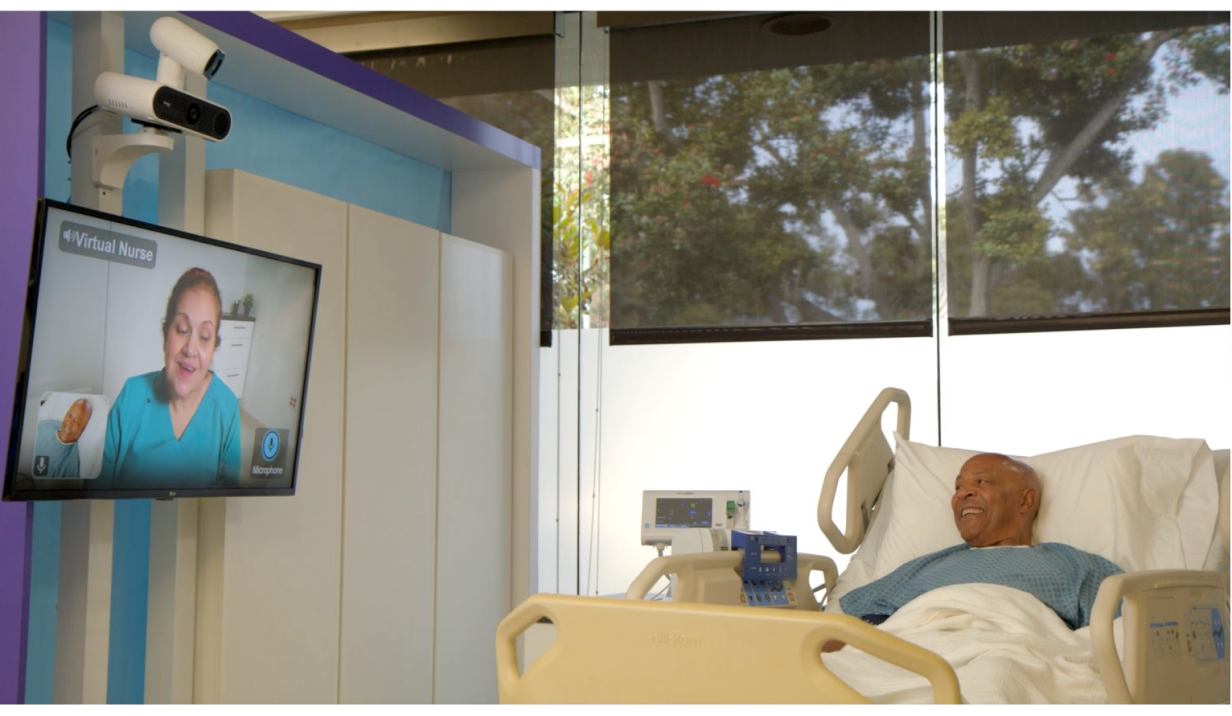
Telehealth capabilities for every patient via their TV in the room
Sitters assist with fall prevention, behavioral monitoring, delirium management, and more, but their workflows are often unsupported by current tools. We set out to change that.
Understanding
What is a sitter
Interviews revealed that virtual sitters are a diverse group, including both recent graduates and experienced bedside workers. They bring skills like medical terminology knowledge, managing monotony and multitasking, building trust through remote communication, de-escalating situations with reflective listening, and working patiently with demanding patients and busy staff.
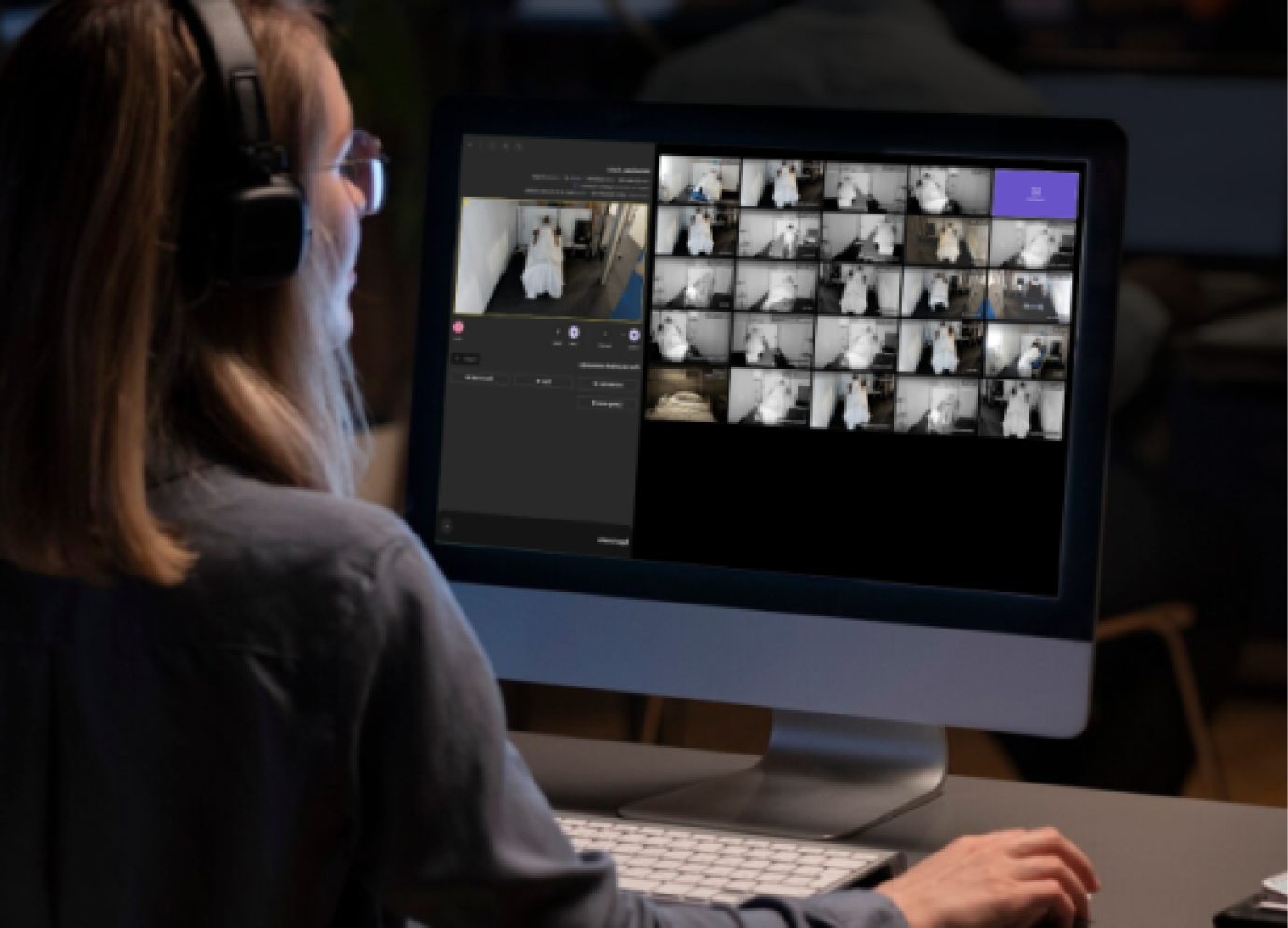
Virtual sitter monitoring
"In this role, you're always on high alert and hyper-focused."
Sitter's Responsibilities and Challenges
The role of virtual sitters presents unique challenges and opportunities for improvement.
At the start of their 12-hour shift, sitters set up workspaces and check in with bedside staff to get up to speed. However, staying informed and managing communication remains difficult due to multiple tools and the fast-paced healthcare environment. When assigned a new patient, sitters often work with incomplete information to understand why monitoring is needed and ensure video equipment functions properly.
During monitoring, virtual sitters face the following challenges:
- 1. Having incomplete information
- 2. Needing to quickly get up to speed on various patients
- 3. Needing to simultaneously document and pay attention to multiple patients
- 4. Needing to share information with other team members during handoff points
Addressing these challenges to enhance the virtual sitter experience was imperative to optimize their efficiency and effectiveness in providing attentive patient care.
Approach
Sprint
To rapidly align the team and reduce risk, I led a Design Sprint focused on sitter workflows. We prototyped and tested early concepts with clinical users, uncovering key pain points in sitter-to-nurse handoff and risk detection at scale. This sprint clarified our roadmap and surfaced foundational needs for scalable alerting and patient context awareness.
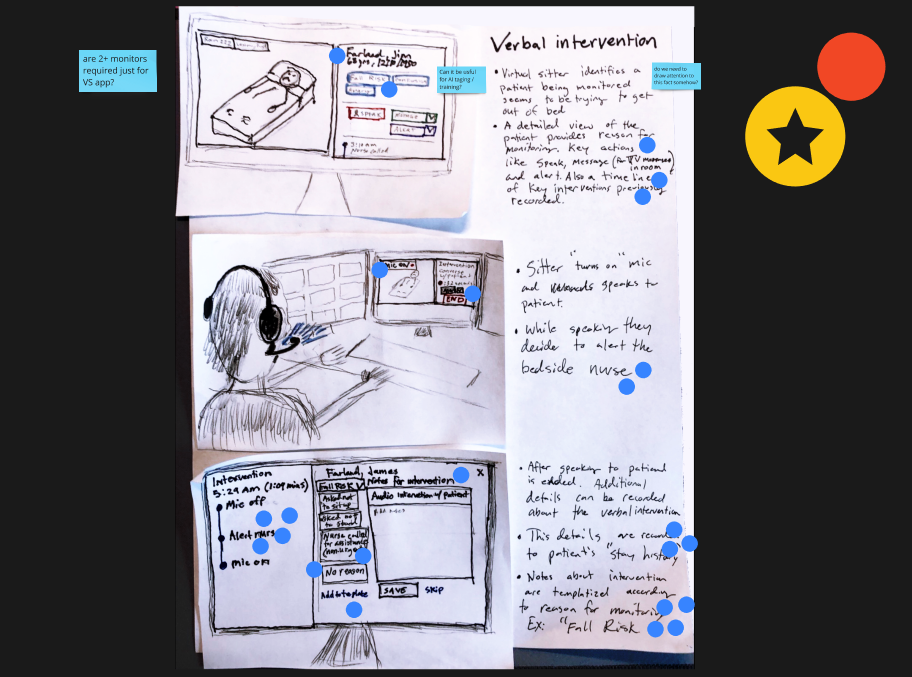
Verbal directives idea
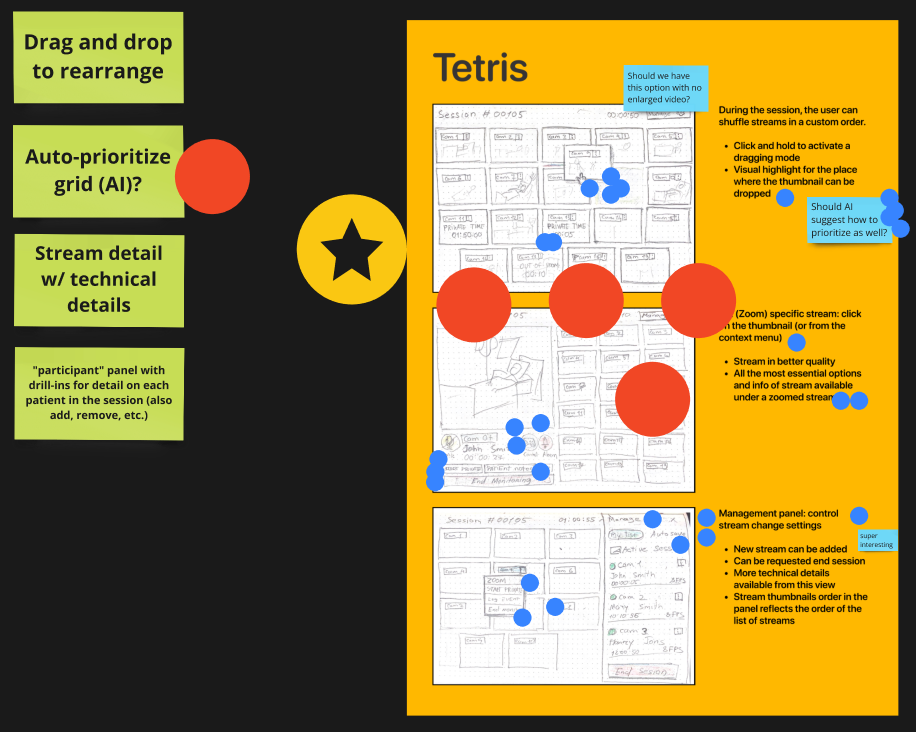
Tetris grid
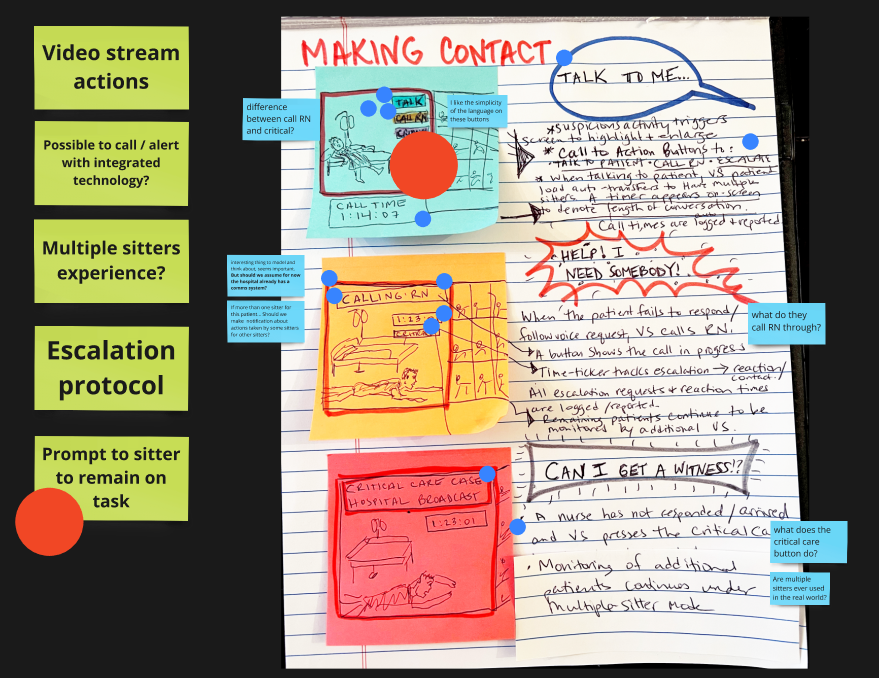
Making contact
By the end, we had a clear vision and concept for the Virtual Sitter platform, informing the product roadmap and highlighting areas needing further research, such as bedside team communication.
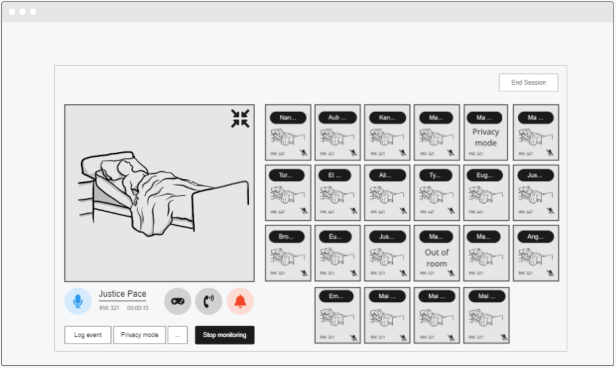
Concept from Sprint
Product needs
Based on the Design Sprint findings, we developed sitter-centric product goals to enhance virtual sitter responsibilities while safely increasing patient capacity. Key areas include:
- • Efficiently monitoring up to 25 patients across various devices and locations.
- • Starting, pausing, and ending patient monitoring.
- • Registering patients until the platform syncs with the electronic health record (EHR).
- • Facilitating one-way and two-way communication between sitters and patients.
- • Supporting multilingual communication for diverse patient needs.
- • Enabling patient transfers between sitters for shift changes.
- • Allowing sitters to document events and interactions.
- • Providing real-time data for managing monitored patients.
Guiding experience principles
Based on the findings of the Design Sprint, we developed a sitter-centric product plan and goals. Patient safety and clear communication experience principles are critical for the success of the Virtual Sitter platform and serve as the backbone of our designs. Our product goals centered on empowering virtual sitters to carry out their responsibilities and tasks while effectively monitoring patients, and on meeting the business need to safely increase the number of patients each sitter can oversee:
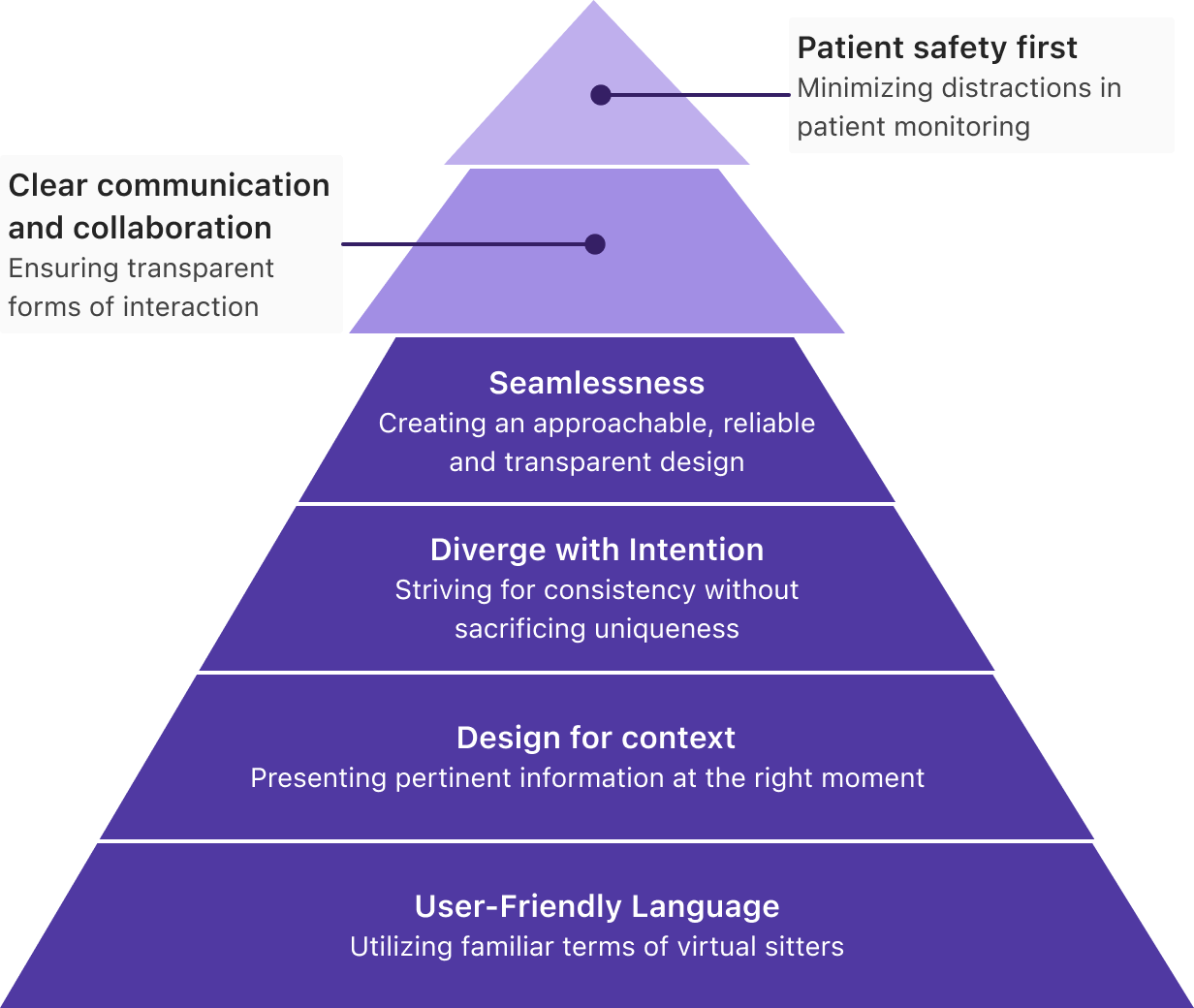
Design principles hierarchy
Reducing Rework Through Alignment
To meet an aggressive four-month timeline, I led a design process that stayed two sprints ahead of engineering—giving us space to validate edge cases, test risky ideas, and ensure technical feasibility without compromising sitter workflows. But staying ahead wasn't enough—we also had to align across deeply siloed roles. I facilitated weekly triads with engineering, ops, and care staff to bridge their perspectives. These weren't just check-ins—they were working sessions where we translated clinical realities into scalable product decisions. That rhythm helped reduce rework, uncovered hidden blockers early, and ensured that what worked for nurses also scaled in code and operations.
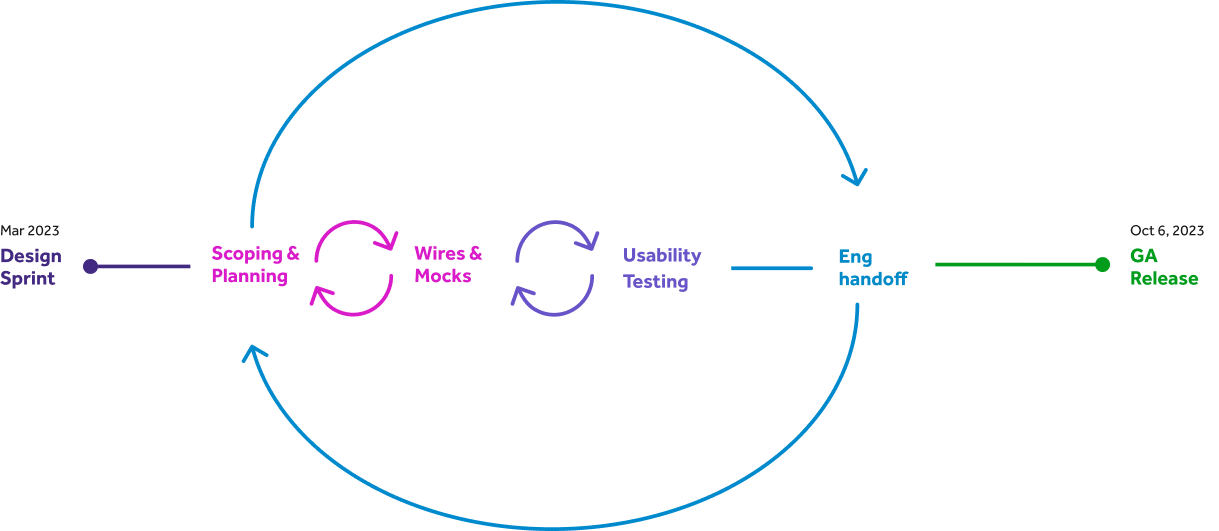
Design process timeline
Scaling Through Mentorship
One of our junior designers was assigned a high-ambiguity feature—Room Insights, which surfaced real-time telemetry about patient room activity. There were no existing UX patterns to lean on, and the data needed to be translated into a clear, sitter-friendly view.
Rather than just reviewing their work, I built a structure around them. I set up a "three-legged stool" with PM and engineering, coached them through writing briefs, aligning stakeholders, and running weekly design jams to gather fast feedback from ops and clinical staff.
They led the feature from concept to delivery—growing in confidence, earning stakeholder trust, and setting a new quality bar for the team. That success became a model for how we mentor designers on ambiguous 0→1 features.
Interface Decisions That Keep Sitters in Control
Being Intentional
Validation and testing sometimes slowed mockup creation, but staying two sprints ahead of engineering allowed for intentional design. This ensured a clear information architecture and smooth user experience. For example, when sitters enlarge a patient's video feed, the simple, logical design supports quick decision-making and efficient escalation during incidents.

Patient monitoring interface with intervention controls
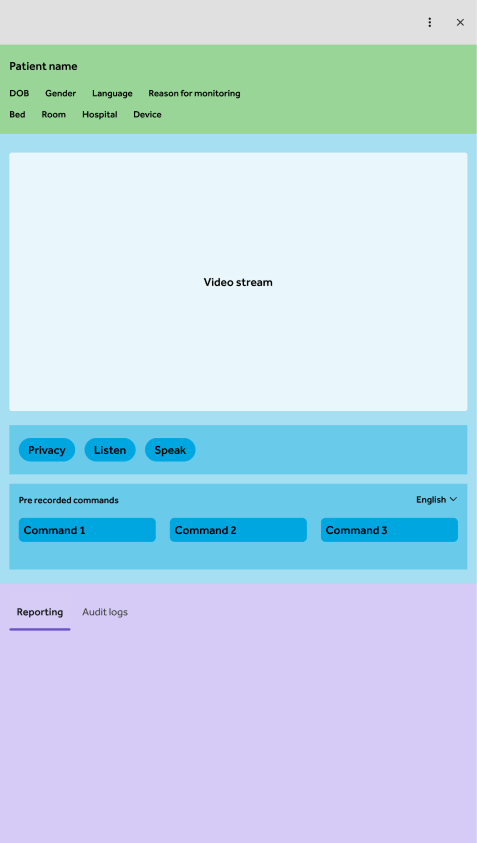
Revised IA
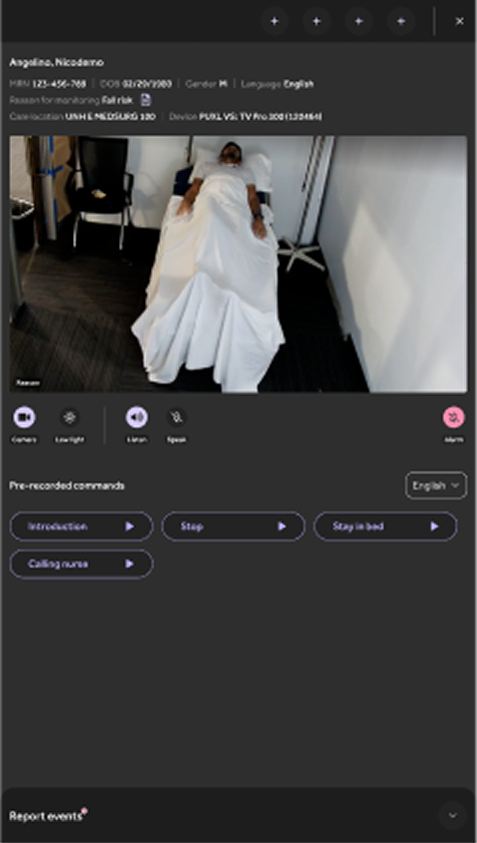
Revised panel
Empowering Sitters to Speak Every Language
By collaborating with users, product designers, and localization teams, we identified the four most common phrases sitters use with patients. These were translated into 30 languages, recorded by AI, and reviewed for accuracy. Now, virtual sitters can deliver these key phrases with a single tap, improving communication with non-English-speaking patients.

Most common communication phrases translated.
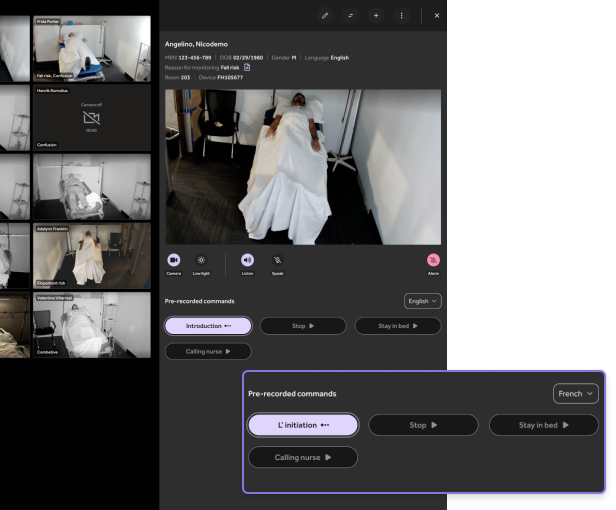
Multilingual interface allowing sitters to communicate with patients in their preferred language
Motion detection with AI
To help sitters focus on the right patient, we added AI-driven motion detection to the grid view. A visual cue now alerts sitters to patient movement or elevated fall risk, enabling timely intervention and improved patient safety.
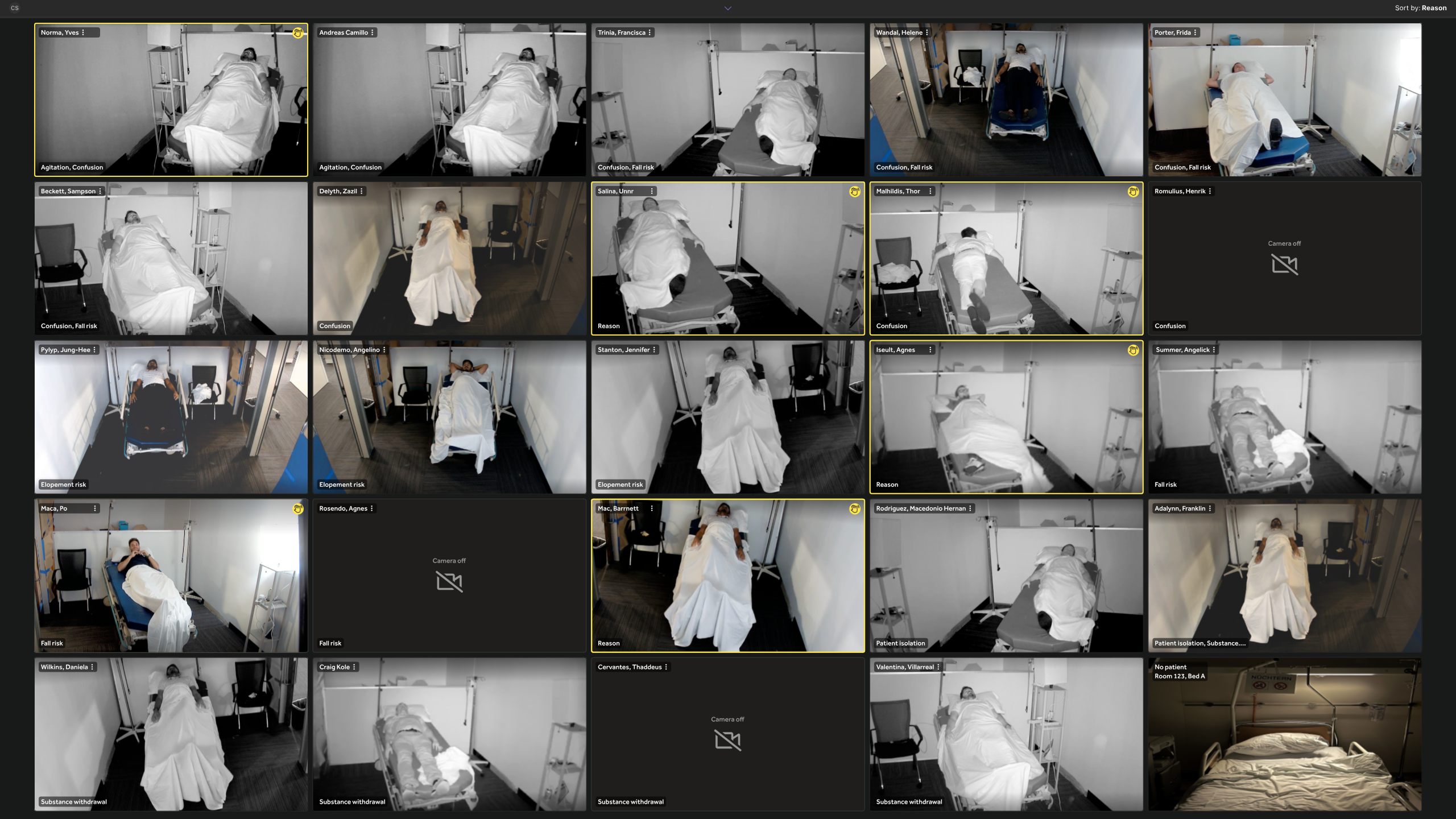
AI motion detection alerts help sitters identify patients requiring immediate attention
Scalable layout for every sitter environment
Sitters often monitor 8–25 patients at once. I designed a responsive grid layout that fills the browser window and scales video tiles to the largest possible size:
Dynamic resizing: Tiles automatically grow or shrink based on patient count and screen size
Live reflow: As patients are added, removed, or disconnected, the layout smoothly animates into a new configuration
Monitor adaptability: Some hospital systems deployed sitters with 4K TV displays (3840×2160), while others used standard HD monitors (1920×1080). The layout scaled seamlessly to any setup, ensuring sitters always had optimal visibility regardless of screen resolution
To better communicate this fluid, screen-responsive behavior, I moved beyond Figma and built a live prototype using v0.dev. This allowed the team to interactively explore how the grid adjusts in real time based on the number of video feeds and the sitter's display size—capturing the product's flexibility in a way static mockups couldn't.
Drag the bottom edge to resize and see how the grid layout adapts
Dynamic Video Grid Layout: adjust the slider or resize the window to see the grid respond
This design ensured subtle visual cues—like posture shifts, limb movement, or patient agitation—were always visible across diverse hardware environments.
Customizable tile sorting for better triage
Each sitter's shift varies. To adapt to changing needs, I introduced two methods for reordering patient tiles:
Drag-and-drop: Sitters can reprioritize patients in real time based on behavior or risk
Sort dropdown: Tiles can be ordered by room number, nurse assignment, or severity
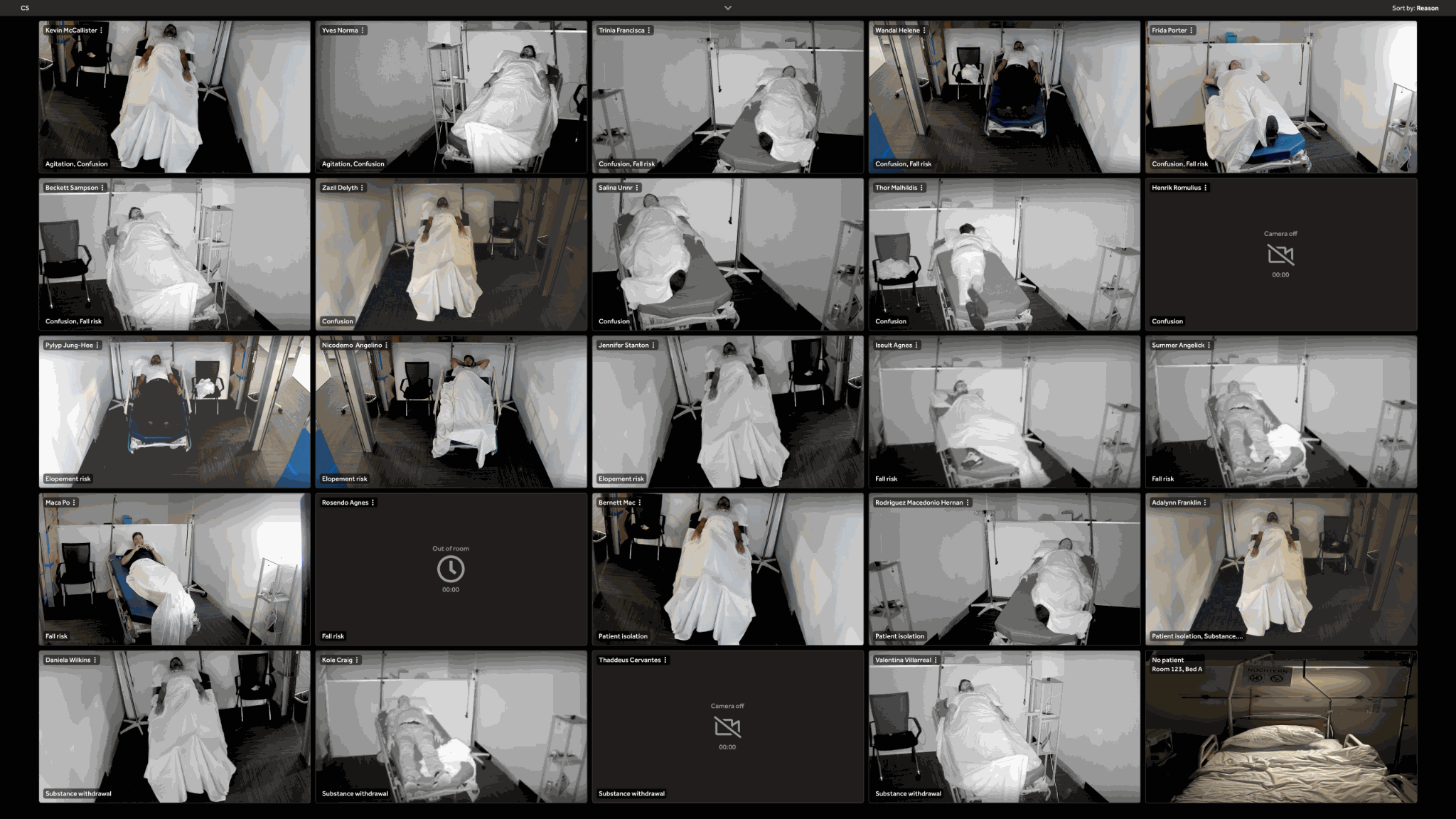
Drag-and-Drop Prioritization
This flexibility helped sitters respond faster to high-risk patients while also supporting consistency across shifts and locations.
Reporting patient events
Virtual sitters document events like falls and interventions to anticipate patient needs and plan responses. They can quickly log incidents using a collapsible list of pre-configured options and add comments about interactions, keeping the list collapsed to maintain focus on patient care.
This documentation aids other sitters and managers in identifying incidents and helps hospitals evaluate the effectiveness of their virtual sitter programs.
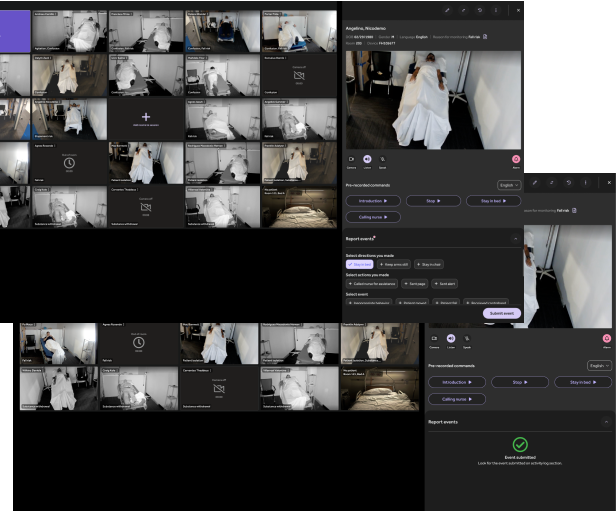
Event documentation interface within the patient monitoring grid
Testing experiences and Facilitating
We developed prototypes for usability testing and to explore the interaction of functionalities, visual language, animations, and information hierarchy. This included integrating videos into the grid view and testing alarming sounds for escalated issues, showcasing how our solution enhances the virtual sitter platform and user experience.
For example, the integration of motion detection helps sitters focus on patient activities. Our success stemmed from designers embracing their roles as listeners and facilitators.
Impact That Drove Adoption
These results helped convert 3 hospital systems away from legacy competitors and became a pillar of Teladoc's inpatient product strategy.
Impact
Adoption & Growth
- • Adopted by 10+ hospital systems
- • New clients switched from legacy tools due to superior usability and faster time-to-action
Staff Efficiency
- • Reduced time-on-task by 20% for redirecting patients and alerting nurses
- • Cut non-critical sitter alerts by 35%
Business Differentiation
- • Contributed to RFP wins by positioning UX as a competitive advantage
Recognition
- • 2024 Illumi Award for Excellence in Clinical Usability
Voice of the customer
"With Virtual Sitter, I can see all my patients at once and not have to walk from room to room or rely on the patients communicating through the communication system. This would make my role easier, and I would be able to continually look out for my patients and keep them safe."
"I wish my workplace implemented virtual sitter way sooner. In my role, I'm often on my feet, responding promptly to alerts and checking on patients. This tool offers a streamlined approach, allowing me to monitor all my patients simultaneously from one location, which greatly simplifies my daily tasks."
Future and holistic care system
The vision for this product is not static. It is an ongoing evolution, a continuous refinement aimed at enhancing the virtual sitter's shift experience and simplifying their tasks. This evolution also extends to how the product integrates into the clinical platform, ensuring it remains at the forefront of healthcare technology.
After discussions with several customers, we integrated virtual sitters into our Inpatient Connected Care product. This enhancement will allow healthcare facilities to utilize their existing staff better or hire new staff for virtual or hybrid inpatient care. The integration is designed to provide greater flexibility and efficiency in patient care management, enabling users to fulfill various roles on different days and adapt to changing patient needs.